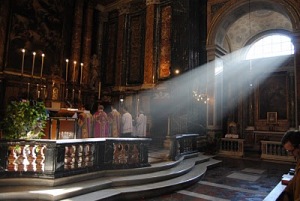What does it mean to celebrate the Mass “ad orientem?”
Literally it means to celebrate the Mass with the priest celebrant facing “to the East,” from whence Christ will come in all His glory for the final judgment at the end of time. At one time, most churches were built so that the priest faced “to the east,” which on first glance meant he celebrated Mass with his back to the people; however, that’s a misstatement of both what is actually happening as well as essential symbolism and reality.
In fact the priest celebrating the Mass “ad orientem,” in a beautiful and timeless manner that speaks powerfully of the necessary humility of the priest before the triune God, celebrates the Mass as alter Christus both on behalf of and with the faithful of the congregation.
There is something both beautiful and even reassuring to be gained from a right understanding the “ad orientem” orientation. What sometimes we glean intuitively from what takes place in all liturgy is inevitably colored by our “gut” feelings and a perception that is colored from our culture and even from wrong explanations from some who should know better. Our intuitive feelings can mislead us into misunderstanding.
Consider this excerpt from recent reflections of Bishop Edward J. Slattery of the Diocese of Tulsa:
“In the past 40 years, however, this shared orientation [ad orientem -Ed.] was lost; now the priest and the people have become accustomed to facing in opposite directions. The priest faces the people while the people face the priest, even though the Eucharistic Prayer is directed to the Father and not to the people.
“This innovation was introduced after the Vatican Council, partly to help the people understand the liturgical action of the Mass by allowing them to see what was going on, and partly as an accommodation to contemporary culture where people who exercise authority are expected to face directly the people they serve, like a teacher sitting behind her desk.
“Unfortunately this change had a number of unforeseen and largely negative effects. First of all, it was a serious rupture with the Church’s ancient tradition. Secondly, it can give the appearance that the priest and the people were engaged in a conversation about God, rather than the worship of God. Thirdly, it places an inordinate importance on the personality of the celebrant by placing him on a kind of liturgical stage.”
It should be clear that it is far from accurate to see the priest with his “back to the people.” In fact of the 25-or-so liturgies approved for use by the Church, Eastern Catholic liturgies (accounting for about 22 of the 25 aforementioned liturgies) never abandoned the practice of celebrating liturgy “ad orientem.”
A proper understanding of “ad orientem,” in fact, reveals considerable forethought and beauty which in my particular case, inspires a sense of deep reverence for priest-as-symbol of humility that bespeaks of Christ whose humility was an aspect of His infinite love for us; similarly the priest acting in the role of alter Christus, which knows no obsolescence in any age.
Link to the article from the Diocese of Tulsa
Filed under: Catechesis in timeless beauty, Catholic History, TLM | Leave a comment »












